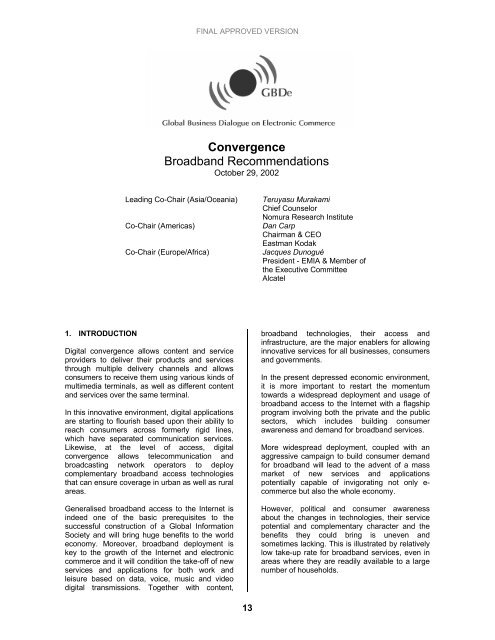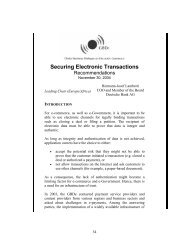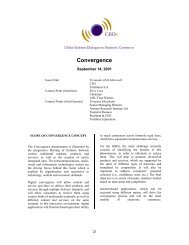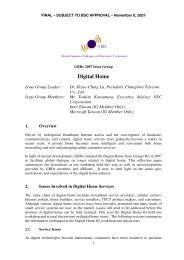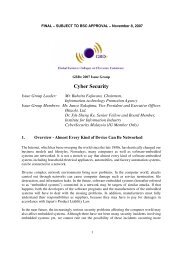EN PDF 130KB - Global Business Dialogue on Electronic Commerce
EN PDF 130KB - Global Business Dialogue on Electronic Commerce
EN PDF 130KB - Global Business Dialogue on Electronic Commerce
Create successful ePaper yourself
Turn your PDF publications into a flip-book with our unique Google optimized e-Paper software.
FINAL APPROVED VERSION<br />
C<strong>on</strong>vergence<br />
Broadband Recommendati<strong>on</strong>s<br />
October 29, 2002<br />
Leading Co-Chair (Asia/Oceania)<br />
Co-Chair (Americas)<br />
Co-Chair (Europe/Africa)<br />
Teruyasu Murakami<br />
Chief Counselor<br />
Nomura Research Institute<br />
Dan Carp<br />
Chairman & CEO<br />
Eastman Kodak<br />
Jacques Dunogué<br />
President - EMIA & Member of<br />
the Executive Committee<br />
Alcatel<br />
1. INTRODUCTION<br />
Digital c<strong>on</strong>vergence allows c<strong>on</strong>tent and service<br />
providers to deliver their products and services<br />
through multiple delivery channels and allows<br />
c<strong>on</strong>sumers to receive them using various kinds of<br />
multimedia terminals, as well as different c<strong>on</strong>tent<br />
and services over the same terminal.<br />
In this innovative envir<strong>on</strong>ment, digital applicati<strong>on</strong>s<br />
are starting to flourish based up<strong>on</strong> their ability to<br />
reach c<strong>on</strong>sumers across formerly rigid lines,<br />
which have separated communicati<strong>on</strong> services.<br />
Likewise, at the level of access, digital<br />
c<strong>on</strong>vergence allows telecommunicati<strong>on</strong> and<br />
broadcasting network operators to deploy<br />
complementary broadband access technologies<br />
that can ensure coverage in urban as well as rural<br />
areas.<br />
Generalised broadband access to the Internet is<br />
indeed <strong>on</strong>e of the basic prerequisites to the<br />
successful c<strong>on</strong>structi<strong>on</strong> of a <str<strong>on</strong>g>Global</str<strong>on</strong>g> Informati<strong>on</strong><br />
Society and will bring huge benefits to the world<br />
ec<strong>on</strong>omy. Moreover, broadband deployment is<br />
key to the growth of the Internet and electr<strong>on</strong>ic<br />
commerce and it will c<strong>on</strong>diti<strong>on</strong> the take-off of new<br />
services and applicati<strong>on</strong>s for both work and<br />
leisure based <strong>on</strong> data, voice, music and video<br />
digital transmissi<strong>on</strong>s. Together with c<strong>on</strong>tent,<br />
broadband technologies, their access and<br />
infrastructure, are the major enablers for allowing<br />
innovative services for all businesses, c<strong>on</strong>sumers<br />
and governments.<br />
In the present depressed ec<strong>on</strong>omic envir<strong>on</strong>ment,<br />
it is more important to restart the momentum<br />
towards a widespread deployment and usage of<br />
broadband access to the Internet with a flagship<br />
program involving both the private and the public<br />
sectors, which includes building c<strong>on</strong>sumer<br />
awareness and demand for broadband services.<br />
More widespread deployment, coupled with an<br />
aggressive campaign to build c<strong>on</strong>sumer demand<br />
for broadband will lead to the advent of a mass<br />
market of new services and applicati<strong>on</strong>s<br />
potentially capable of invigorating not <strong>on</strong>ly e-<br />
commerce but also the whole ec<strong>on</strong>omy.<br />
However, political and c<strong>on</strong>sumer awareness<br />
about the changes in technologies, their service<br />
potential and complementary character and the<br />
benefits they could bring is uneven and<br />
sometimes lacking. This is illustrated by relatively<br />
low take-up rate for broadband services, even in<br />
areas where they are readily available to a large<br />
number of households.<br />
13
FINAL APPROVED VERSION<br />
Moreover, obstacles that currently impede the<br />
deployment pace of broadband networks, such as<br />
regulatory uncertainty, c<strong>on</strong>tribute to a general<br />
decline in investment capital. Without challenging<br />
the fundamental GBDe principle that selfregulati<strong>on</strong><br />
by private enterprise is, in most cases,<br />
preferable to interventi<strong>on</strong> by public authorities,<br />
governments do have a role to play here; by<br />
developing new broadband communicati<strong>on</strong>s<br />
policies taking into account media and<br />
telecommunicati<strong>on</strong>s policy c<strong>on</strong>siderati<strong>on</strong>s, they<br />
can ease the deployment of market-led<br />
broadband technologies, hence boosting the use<br />
of Internet and growth of e-business and e-<br />
practices. And by becoming an “early adopter”<br />
and user of broadband applicati<strong>on</strong>s, governments<br />
can encourage c<strong>on</strong>sumer awareness of the<br />
benefits of broadband services.<br />
The GBDe supports the European Commissi<strong>on</strong>’s<br />
eEurope 2005 Acti<strong>on</strong> Plan which reflects many<br />
proposals that GBDe has put forward.<br />
2. WORKING DEFINITION OF "BROADBAND"<br />
In the light of recently published broadband policy<br />
reports (OECD, Canada, UK, European Uni<strong>on</strong>), a<br />
general c<strong>on</strong>sensus has emerged as to the<br />
necessity of viewing “broadband” primarily from<br />
the end-user perspective, namely, what<br />
broadband can deliver (end-user applicati<strong>on</strong>s and<br />
services) as separate from the access platform<br />
(xDSL, cable, satellite, WLL, mobiles, etc.).<br />
In the c<strong>on</strong>text of highlighting “c<strong>on</strong>sumer interests”,<br />
the definiti<strong>on</strong> of broadband remains open and<br />
“dynamic”, disregarding any specific transmissi<strong>on</strong><br />
speeds. Focus should be <strong>on</strong> broadband’s<br />
inherent capabilities such as interactivity, richness<br />
of c<strong>on</strong>tent, quality of service and multi-modal<br />
video delivery. GBDe positi<strong>on</strong>s should build <strong>on</strong><br />
the end-user perspective:<br />
• to address more accurately and rapidly<br />
c<strong>on</strong>sumer interests and key factors of<br />
c<strong>on</strong>sumer c<strong>on</strong>fidence;<br />
• to determine those mass-market c<strong>on</strong>diti<strong>on</strong>s<br />
required for stimulating broadband growth.<br />
3. RECOMM<str<strong>on</strong>g>EN</str<strong>on</strong>g>DATIONS<br />
The GBDe has identified the demand-side as the<br />
key to boosting broadband and it is demand-side<br />
which the GBDe urges governments to adopt as<br />
their focus for encouraging the adopti<strong>on</strong> of<br />
broadband.<br />
applicati<strong>on</strong>s, by offering new services <strong>on</strong>line and<br />
by generating new broadband usage.<br />
To this end, public authorities at all levels would<br />
be urged to:<br />
• Aggregate public sector demand for<br />
broadband to ensure smart procurement<br />
using the combined purchasing power of<br />
public sector organisati<strong>on</strong>s as a catalyst for<br />
the private sector;<br />
• Develop e-government applicati<strong>on</strong>s and<br />
services (in the areas of tax, social security,<br />
health, educati<strong>on</strong> and transport) to allow<br />
citizens to interact with Government <strong>on</strong>line<br />
from any kind of broadband terminal or<br />
access point.<br />
Other urgent policy steps include:<br />
• The regulatory envir<strong>on</strong>ment should c<strong>on</strong>sider<br />
the need for payback of investments of both<br />
incumbent and competitive providers, without<br />
deviating from the important policy objective<br />
of establishing, maintaining and encouraging<br />
competiti<strong>on</strong>.<br />
• Identificati<strong>on</strong> and eliminati<strong>on</strong> of obstacles to<br />
the development of <strong>on</strong>line c<strong>on</strong>tents and<br />
activities, particularly regarding e-learning, e-<br />
health and e-business, by the private as well<br />
as public sectors;<br />
• Facilitati<strong>on</strong> of a secure informati<strong>on</strong><br />
infrastructure;<br />
• Setting-up a competitive framework giving<br />
rise to innovative and sound business<br />
models;<br />
• Facilitati<strong>on</strong> of open and interoperable<br />
standards for technological protecti<strong>on</strong> of<br />
c<strong>on</strong>tent in order to support the supply of<br />
demand-oriented media-rich c<strong>on</strong>tent to foster<br />
new forms of c<strong>on</strong>sumpti<strong>on</strong>;<br />
• Educati<strong>on</strong> of citizens to the need for copyright<br />
protecti<strong>on</strong>.<br />
On the supply-side of the equati<strong>on</strong>, regi<strong>on</strong>al as<br />
well as central governments should pay c<strong>on</strong>tinued<br />
attenti<strong>on</strong> to situati<strong>on</strong>s where there is no<br />
commercially sustainable business case to deploy<br />
broadband infrastructure.<br />
In particular, governments can greatly help<br />
moving towards a “critical mass” of end-users and<br />
14


